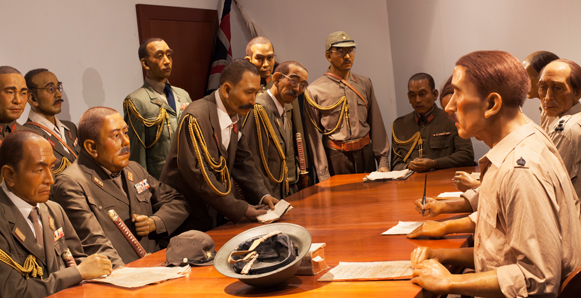February…Chinese New Year festivities and the month of love and romance! But do you remember the important event Singapore commemorates in the same month?
Observed annually on 15 February, Total Defence Day marks Singapore’s fall to the Japanese in 1942. This commemoration seeks to remind people of the pain and suffering endured by our forefathers during the Japanese Occupation, as well as to instill the strategy of “Total Defence” in our people, understanding that each one has a part to play in the survival of our country.
To learn more about the Japanese Occupation in Singapore and the tenacious spirits of our forefathers in protecting this land, here are the 5 war museums in Singapore you should visit.
1. Fort Siloso

Located on Sentosa Island, Fort Siloso is the only preserved coastal fort in Singapore today. It was initially built in the 1880s to protect the island from sea invasion, and the guns were turned inwards facing the land when the Japanese invaded during World War II. Upon seizing Singapore, the Japanese used the fort as a prisoner-of-war (POW) camp.
Today, Fort Siloso is a military museum with gun displays and remains of military structures and tunnels. Admission is free, but admission into the Surrender Chambers is chargeable. The Surrender Chambers feature waxworks of the British Surrender at the Old Ford Factory, commentaries, and exhibitions. Guided tours are available too.
Siloso Point, Sentosa Island
Daily: 10am-6pm (last entry at 5.30pm)
2. Changi Museum

The Changi Museum provides valuable but heartwrenching insights of the POWs who were taken into captivity during the Japanese Occupation. The exhibitions are split into five sections, showing visitors what happened during the war through a collection of photographs, paintings, letters and personal artefacts donated by former POWs. Wartime art pieces produced by the prisoners are also on display, recording their experiences in Changi Prison. Changi Chapel, dedicated to the memory of the POWs and the civilian internees, is located on the museum grounds as well.
Visitors can choose to go on a guided tour, or rent an audio set to listen to first-hand stories and experiences of the POWs.
1000 Upper Changi Road North
Daily: 9.30am-5pm (last entry at 4.30pm)
3. Reflections at Bukit Chandu

Reflections at Bukit Chandu is a heritage centre housed in a restored colonial bungalow. Bukit Chandu (Malay for Opium Hill) was where one of the fiercest and last significant battles took place before the British surrendered Singapore to the Japanese. The Battle of Pasir Panjang, also known as the Battle of Bukit Chandu, saw 1400 valiant soldiers from the Malay Regiment fight dauntlessly against a 13 000 strong Japanese army. Despite being severely outnumbered, Lieutenant Adnan Saidi refused to retreat and surrender, and the troops even engaged in hand-to-hand combat after running out of ammunition.
The museum exhibits photographs, maps, artefacts and interactive media, showcasing the tenacity of the Malay Regiment, and other wartime experiences.
31-K Pepys Road
Tues-Sun: 9am-5.30pm
Closed on Mondays, except on Public Holidays
4. The Battle Box

The Battle Box is a 9m deep emergency bunker located beneath Fort Canning Hill, where the British army set up their headquarters in Singapore. It was once the nerve centre of British military operations, consisting of 30 rooms including a cipher room where messages were decoded, a signal control room, and a gun operations room.
The Battle Box is also the site where Lieutenant-General Arthur Percival, the General Officer Commanding (Malaya), held a conference to discuss the war situation with other commanders, and then reached the decision to surrender to the Japanese.
The bunker was later converted into a museum in 1992, with artefacts on display depicting the final days before Singapore fell to the Japanese. It has recently undergone a revamp, and will feature multimedia guides, 3D technologies, and a retelling of the story of Singapore’s capture.
2 Cox Terrace
Reopening in March 2016
5. Memories at Old Ford Factory

The Ford Motor Factory was the site where the British surrendered Singapore to the Japanese on 15 February 1942, drastically altering the lives of the people in Singapore. Lieutenant-General Tomoyuki Yamashita, head of the Japanese invading forces, seized the factory as his headquarters after capturing Bukit Timah, and demanded for the British’s unconditional surrender.
During the Japanese Occupation, the factory was used to assemble military trucks and other vehicles for the Japanese war effort. Today, the restored factory captures the memories and reflections of the hardships faced by those who had lived through the war. Visit the Boardroom of Surrender where the Surrender Papers were signed, and the Syonan Garden where some of the common food items during the wartime are grown. The Talking Map is an interactive exhibit that traces the route of the Japanese as the advanced into Singapore, with oral histories and first-hand experiences of survivors of the war.
351 Upper Bukit Timah Road
Mon-Sat: 9am-5.30pm
Sun: 12pm-5.30pm
Closing on 16 Feb 2016
Reopening in 2017
(Featured Image Credits: Sentosa)






